|
Age 5-8
Art
Activities
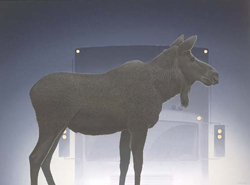 The word 'silhouette'
is a French word that means the representation of something in outline.
Silhouettes were popular from 1760 to 1860 as an inexpensive way to have
a likeness done. When photography was invented, the art of the silhouette
declined.
The word 'silhouette'
is a French word that means the representation of something in outline.
Silhouettes were popular from 1760 to 1860 as an inexpensive way to have
a likeness done. When photography was invented, the art of the silhouette
declined.
Over the years, Christopher Pratt has come across several moose on the roads
in Newfoundland. He recalls them caught, silhouetted in the glare of oncoming
headlights.
Moose and Transports (1993) shows a profile of a bewildered
moose, seemingly paralyzed in the approaching noise and light.
Make a personality silhouette of yourself.
Materials:
·1 sheet black construction paper
· 1 sheet white construction paper
Directions:
1. Find a strong light and place it in such a way that it casts a shadow
of your profile on the wall.
2. Tape white construction paper to the wall in the spot where your shadow
appeared. Ask a friend to trace the shadow of your profile onto the paper.
3. Remove the white paper from the wall and place the black paper beneath it.
Following your outline, cut through both sheets of paper. This will give you two
identical profiles.
4. Use the white profile to show things about yourself - make simple images
of the things you like to do, places you like to go, things that you think
about. Paste these images inside the outline of your head. Your finished
work will show people not just how you look in silhouette but also who
you are.
5. When you are finished colouring your drawings, place this white profile
on top of the black one, allowing the black one to protrude a bit in order
to emphasize your white profile.
Sgraffito
Create an animal image that closely resembles you by doing a sgraffito (an Italian word
meaning scratch) using oil pastels. Explain your choice of animal by describing
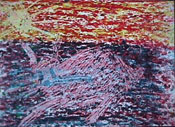 what you have in common with it. Include in your explanation any mythological stories or
symbolic attributes your chosen animal has.
what you have in common with it. Include in your explanation any mythological stories or
symbolic attributes your chosen animal has.
Materials:
· nail/knitting needle/pen
Directions:
1. Use at least two layers of different coloured pastels to cover the whole surface of your paper.
2. Scratch your lines into the top layer of colour, allowing the colour beneath to show through. Drawing utensils are not limited to those suggested in the materials list. Wire, fingernails, rocks and straws are also possible drawing tools.
3. Correct mistakes by colouring over the accidental scratch. Your animal image should cover the entire sheet of paper. Sketch the outline in pencil if you do not feel like working freehand with your drawing utensil.
Monoprinting
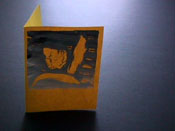 Unlike other forms
of printing that Christopher Pratt practices (etching and lithography)
monoprinting is a means of producing a single print of an image. It is
not a complicated process and little equipment is required. Unlike other forms
of printing that Christopher Pratt practices (etching and lithography)
monoprinting is a means of producing a single print of an image. It is
not a complicated process and little equipment is required.
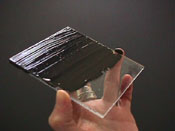
Materials:
· Tempera paint any colours
· Paintbrushes of varying widths
· Plexi-glass plates cut to any size
· Drawing objects (sticks, q-tips, rags, sponges)
· Paper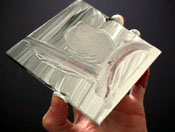
· Rags and a cup for water for cleaning brushes
Directions:
1. Cover plexi-glass plate with an even layer of tempera paint.
2. Use your finger, brush, etc. or wipe away paint with rag or sponge
to produce an image.
3. Carefully press a sheet of paper on to the plate and rub gently with
the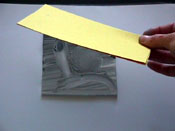 back of your fingers. Do not press too hard and squash the image!
back of your fingers. Do not press too hard and squash the image!
4. Lift the paper when you have rubbed the whole image area. The print
will be a reverse of the original image. If you do not spell your name
or a word backwards on the plexi-glass plate, it will be backwards on
your print.
Crayon Masking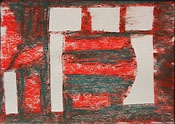
Materials:
· Masking tape (painter's tape is recommended - it isn't as adhesive
as regular masking tape)
Directions:
1. Cut shapes of masking tape and use them to construct a complete picture.
Use two or more strips together to make wide broad lines. Be sure the tape lies flat. 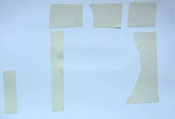
2. Cover the entire surface with crayon.
3. Carefully remove the tape from the picture.
Transport Pictures
Invent a fantasy form of transport.
Materials: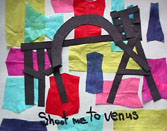
· Large piece of white paper for background
· Pieces of tissue paper in bright colours
· Black paper - cut into strips
Directions:
1. Cut the tissue paper into irregular shapes and glue to the white paper
background.
2. Arrange the black paper strips to make a vehicle. Make wheels by cutting rings from black paper and adding strips for spokes.
3. Glue the vehicle on to the tissue-covered background to dry.
Write about what your fantasy transport can do. Does it operate under
water or produce hot chocolate from the exhaust pipe instead of noxious
fumes? Maybe its source of power is used vegetable grease instead of gas.
return to You
Try
return to
Age 5-8
|


 The word 'silhouette'
is a French word that means the representation of something in outline.
Silhouettes were popular from 1760 to 1860 as an inexpensive way to have
a likeness done. When photography was invented, the art of the silhouette
declined.
The word 'silhouette'
is a French word that means the representation of something in outline.
Silhouettes were popular from 1760 to 1860 as an inexpensive way to have
a likeness done. When photography was invented, the art of the silhouette
declined. what you have in common with it. Include in your explanation any mythological stories or
symbolic attributes your chosen animal has.
what you have in common with it. Include in your explanation any mythological stories or
symbolic attributes your chosen animal has.